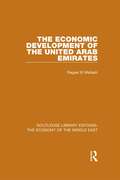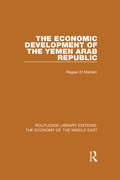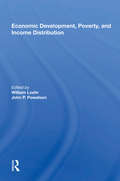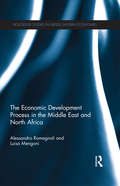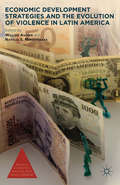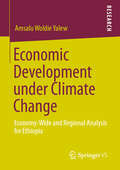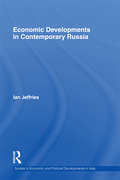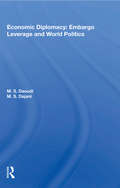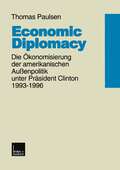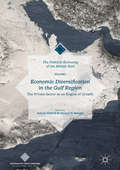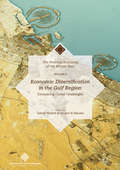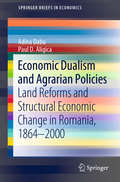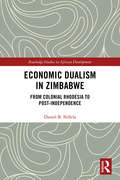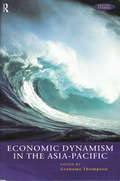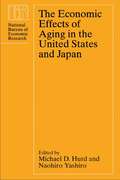- Table View
- List View
The Economic Development of the United Arab Emirates (Routledge Library Editions: The Economy of the Middle East)
by Ragaei el MallakhSince the early 1970s the oil producing countries of the Gulf have become a focus of intense interest worldwide. Most of this interest has centred on the oil giants, Saudi Arabia, Iran, even Iraq and Kuwait. Yet the United Arab Emirates is also among the largest producers, on a par with Kuwait, Nigeria and Libya, with reserves greater than the USA. Given its high economic growth rate, the UAE is an excellent laboratory in which to test and evaluate policies and programmes to effect rapid economic development. The international stature of the UAE far exceeds what its physical size, population and breadth of resources would seem to indicate. As a member of OPEC, the UAE has played a vital role within that body’s ‘price moderates’. With one of the world’s highest per capita incomes and with ambitious development efforts under way, the UAE, not surprisingly, has become a major market for capital and consumer goods, involving substantial foreign services, banking, business and industry. Based on more than a decade of study, on-site research and interviews with key figures, this book – which mixes the practical with the academic approach – will prove of great value to Middle Eastern and development specialists, students and to the international business and financial communities. First published in 1981.
The Economic Development of the United Arab Emirates (Routledge Library Editions: The Economy of the Middle East)
by Ragaei el MallakhSince the early 1970s the oil producing countries of the Gulf have become a focus of intense interest worldwide. Most of this interest has centred on the oil giants, Saudi Arabia, Iran, even Iraq and Kuwait. Yet the United Arab Emirates is also among the largest producers, on a par with Kuwait, Nigeria and Libya, with reserves greater than the USA. Given its high economic growth rate, the UAE is an excellent laboratory in which to test and evaluate policies and programmes to effect rapid economic development. The international stature of the UAE far exceeds what its physical size, population and breadth of resources would seem to indicate. As a member of OPEC, the UAE has played a vital role within that body’s ‘price moderates’. With one of the world’s highest per capita incomes and with ambitious development efforts under way, the UAE, not surprisingly, has become a major market for capital and consumer goods, involving substantial foreign services, banking, business and industry. Based on more than a decade of study, on-site research and interviews with key figures, this book – which mixes the practical with the academic approach – will prove of great value to Middle Eastern and development specialists, students and to the international business and financial communities. First published in 1981.
The Economic Development of the Yemen Arab Republic (Routledge Library Editions: The Economy of the Middle East)
by Ragaei el MallakhThe recent economic development of the Yemen Arab Republic is in stark contrast to the centuries of isolation that had marked the country prior to the 1962 Revolution. When economic planning was instituted in the 1970s, the nation was confronted by the needs of reconstruction after years of conflict, and of development. A formidable task was faced in the need to establish basic infrastructure throughout a country with a widely dispersed population and with extremely rugged terrain. In addition, the economy has been characterized by the high percentage of the workforce attracted overseas as migrant workers. This book provides the first comprehensive study of the economic development of this under-studied nation. First published in 1986.
The Economic Development of the Yemen Arab Republic (Routledge Library Editions: The Economy of the Middle East)
by Ragaei el MallakhThe recent economic development of the Yemen Arab Republic is in stark contrast to the centuries of isolation that had marked the country prior to the 1962 Revolution. When economic planning was instituted in the 1970s, the nation was confronted by the needs of reconstruction after years of conflict, and of development. A formidable task was faced in the need to establish basic infrastructure throughout a country with a widely dispersed population and with extremely rugged terrain. In addition, the economy has been characterized by the high percentage of the workforce attracted overseas as migrant workers. This book provides the first comprehensive study of the economic development of this under-studied nation. First published in 1986.
Economic Development, Poverty, And Income Distribution
by William LoehrThe increasing inequality and poverty that seem inevitably to accompany economic growth in developing countries have become more and more evident in recent years. The search for development paths that lead to growth with equality—all too difficult to find—is now an area of central concern for development economists. One result of their concern is this volume, in which internationally known representatives of a range of disciplines address themselves to ways in which growth with equity might be successfully achieved. The book begins with both empirical and theoretical background to the development issues involved, and with an overview of the experience of the international development assistance community. focuses on operational definitions of the poor that will permit analytical, policy-oriented research to lead to useful conclusions. Specific concern is expressed for small-business owners, women, peasants, and recent migrants from rural to urban areas. The basic question, of course, is what can be done about poverty and inequality. includes suggestions for specific measures and provides a comprehensive comparison across a wide range of policy options. The book does not solve the problem, but it does point to directions that promise a reasonably high probability of success. And throughout, suggestions are made for the kind of interdisciplinary research required to raise that probability even further.
Economic Development, Poverty, And Income Distribution
by William Loehr John P. PowelsonThe increasing inequality and poverty that seem inevitably to accompany economic growth in developing countries have become more and more evident in recent years. The search for development paths that lead to growth with equality—all too difficult to find—is now an area of central concern for development economists. One result of their concern is this volume, in which internationally known representatives of a range of disciplines address themselves to ways in which growth with equity might be successfully achieved. The book begins with both empirical and theoretical background to the development issues involved, and with an overview of the experience of the international development assistance community. focuses on operational definitions of the poor that will permit analytical, policy-oriented research to lead to useful conclusions. Specific concern is expressed for small-business owners, women, peasants, and recent migrants from rural to urban areas. The basic question, of course, is what can be done about poverty and inequality. includes suggestions for specific measures and provides a comprehensive comparison across a wide range of policy options. The book does not solve the problem, but it does point to directions that promise a reasonably high probability of success. And throughout, suggestions are made for the kind of interdisciplinary research required to raise that probability even further.
The Economic Development Process in the Middle East and North Africa (Routledge Studies in Middle Eastern Economies)
by Alessandro Romagnoli Luisa MengoniOffering a comprehensive analysis of the development of economies in the Middle East and North Africa over the past half century, this book charts the progress of these countries through an examination of an Islamic model of economic development, reform processes, and economic integration. Far from being a simple process, economic development in the Middle East and North Africa is dependent on the interaction of a set of changing systems including; international relations, the political regime, economy, and society. By analysing these interdependent factors, The Economic Development Process in MENA seeks to provide answers to the most pressing issues facing the economies in this area. Providing an interpretation of regional development in light of dialectics between state and society, this book will be of value to students and scholars with an interest in the Middle East, Economics, and International Relations.
The Economic Development Process in the Middle East and North Africa (Routledge Studies in Middle Eastern Economies)
by Alessandro Romagnoli Luisa MengoniOffering a comprehensive analysis of the development of economies in the Middle East and North Africa over the past half century, this book charts the progress of these countries through an examination of an Islamic model of economic development, reform processes, and economic integration. Far from being a simple process, economic development in the Middle East and North Africa is dependent on the interaction of a set of changing systems including; international relations, the political regime, economy, and society. By analysing these interdependent factors, The Economic Development Process in MENA seeks to provide answers to the most pressing issues facing the economies in this area. Providing an interpretation of regional development in light of dialectics between state and society, this book will be of value to students and scholars with an interest in the Middle East, Economics, and International Relations.
Economic Development Strategies and the Evolution of Violence in Latin America (Politics, Economics, and Inclusive Development)
by William Ascher and Natalia MirovitskayaEconomic Development Strategies and the Evolution of Violence in Latin America explores the links between Latin American governments' economic policies and the nature and dynamics of inter-group violence. Based on the patterns of ten countries, the contributions to this volume trace the remarkable transformation from open ideological conflict to the explosion of social (seemingly apolitical) violence, the upsurge of urban crime, and the confrontations over natural resources and drugs across the region spanning from Mexico to Argentina. The variations in economic success and in conflict prevention and transformation can guide policymakers, development professionals, and activists committed to conflict-sensitive development.
Economic Development under Climate Change: Economy-Wide and Regional Analysis for Ethiopia
by Amsalu Woldie YalewAmsalu Woldie Yalew attempts to address the direct and indirect economic effects of climate change, adaptation costs, and adaptation finance in developing countries with emphasis to Ethiopia using a static computable general equilibrium (CGE) model coupled with a regional module. The results show that the economy-wide effects of climate change are profound. Planned public adaptation that aims to fully neutralize climate change-induced agricultural productivity shocks may help to avert the aggregate effects but with residual effects. The results also indicate that structural change underpins climate-resilient development as it contributes to dampen the adverse consequences of climate change on aggregate GDP and households’ welfare.
Economic Developments in Contemporary Russia (Guides to Economic and Political Developments in Asia)
by Ian JeffriesThis book provides a comprehensive overview of Russia’s difficult economic transition from a command economy since the early 1990s. It covers the financial crisis of August 1998 and the global financial crisis a decade later. Key subjects covered include economic transition, privatization and liberalization; changes in land ownership and agriculture; energy; foreign direct investment; economic stabilization; and economic performance. Russia is well endowed with raw materials, especially oil and natural gas; this book argues that in some ways this has not helped Russia’s attempts to become a more diversified and high-tech economy. Overall, the book demonstrates how much the Russian economy has changed in the period. It continues - and adds to – the overview of developments in the author’s The New Russia (2002), and is the companion volume to Political Developments in Contemporary Russia (2011) - both published by Routledge.
Economic Developments in Contemporary Russia (Guides to Economic and Political Developments in Asia)
by Ian JeffriesThis book provides a comprehensive overview of Russia’s difficult economic transition from a command economy since the early 1990s. It covers the financial crisis of August 1998 and the global financial crisis a decade later. Key subjects covered include economic transition, privatization and liberalization; changes in land ownership and agriculture; energy; foreign direct investment; economic stabilization; and economic performance. Russia is well endowed with raw materials, especially oil and natural gas; this book argues that in some ways this has not helped Russia’s attempts to become a more diversified and high-tech economy. Overall, the book demonstrates how much the Russian economy has changed in the period. It continues - and adds to – the overview of developments in the author’s The New Russia (2002), and is the companion volume to Political Developments in Contemporary Russia (2011) - both published by Routledge.
Economic Diplomacy: Embargo Leverage And World Politics
by M. S. DaoudiThe 1983 collapse of world oil prices revived memories of a time only a decade earlier when the price of a barrel of oil did not exceed three dollars. By the late 1970s, spot market prices had reached peaks of forty dollars a barrel. A major role in creating these new realities was played by the 1973/1974 Arab oil embargo, which formed the psychological, political, and market conditions for the dramatic price surge. This important study probes the embargo in detail, thoroughly examining its history, the motivations that caused it, and its ripple effect on world politics and the international economic order. The authors carefully examine the interruption of oil supplies to Western Europe during the 1956 Suez Canal crisis, the growing momentum of Arab oil leverage beginning with the First Arab Petroleum Congress in 1959, the decline of the oil companies' domination of the petroleum industry, and the Arab political environment between the 1967 Arab defeat and the 1973 Arab oil embargo. The book concludes with a chapter addressing the lessons to be learned from these recent embargoes.
Economic Diplomacy: Embargo Leverage And World Politics
by M. S. DaoudiThe 1983 collapse of world oil prices revived memories of a time only a decade earlier when the price of a barrel of oil did not exceed three dollars. By the late 1970s, spot market prices had reached peaks of forty dollars a barrel. A major role in creating these new realities was played by the 1973/1974 Arab oil embargo, which formed the psychological, political, and market conditions for the dramatic price surge. This important study probes the embargo in detail, thoroughly examining its history, the motivations that caused it, and its ripple effect on world politics and the international economic order. The authors carefully examine the interruption of oil supplies to Western Europe during the 1956 Suez Canal crisis, the growing momentum of Arab oil leverage beginning with the First Arab Petroleum Congress in 1959, the decline of the oil companies' domination of the petroleum industry, and the Arab political environment between the 1967 Arab defeat and the 1973 Arab oil embargo. The book concludes with a chapter addressing the lessons to be learned from these recent embargoes.
Economic Diplomacy: Die Ökonomisierung der amerikanischen Außenpolitik unter Präsident Clinton 1993–1996
by Thomas Paulsen"It's the economy, stupid!" - das war der innenpolitische Slogan, mit dem Bill Clinton 1992 die Wähler für sich gewinnen konnte. Auch in der Außenpolitik erhob der neue Präsident den Anspruch, das Verhältnis zwischen sicherheits- und wirtschaftpolitischen Prioritäten neu zu ordnen. Ökonomische Ziele sollten von nun an den Kern des außenpolitischen Interessenkalküls der USA bilden. "Economic Diplomacy" wurde zum Leitbild einer neuen Außenpolitik erhoben, nationale Sicherheit als ökonomische Sicherheit neu definiert. Das Buch untersucht, ob hinter dem Label "Economic Diplomacy" tatsächlich ein solch fundamentaler Wandel der amerikanischen Außenpolitik steht. Drei Fragen stehen im Mittelpunkt: Welches waren die Grundzüge der außenpolitischen Agenda Clintons? Was waren die Ideen und Wahrnehmungsmuster hinter dem Konzept der "Economic Diplomacy"? Inwieweit konnte Clinton seine Vorstellungen im außenpolitischen Entscheidungsprozeß und in der operativen Außenpolitik in die Praxis umsetzen?
Economic Diversification in the Gulf Region, Volume I: The Private Sector as an Engine of Growth
by Ashraf Mishrif Yousuf Al BalushiThis volume focuses on the role of the private sector in diversifying the economics of Gulf countries in the post-petrodollar era, when fluctuating and declining oil prices are negatively impacting national expenditures. It explores current policies of countries in the Gulf Cooperation Council and their efforts to shift their economies away from heavy dependence on hydrocarbons. The structural changes will create favorable conditions for the private sector to flourish, shift production dependence from public to private sector, and allow for more efficient resource allocation. Such changes will also allow local banks to provide financial support to small and medium enterprises, boost entrepreneurship for job creation, and strengthen organizational structure and efficiency. This is the first volume in Economic Diversification in the Gulf Region.
Economic Diversification in the Gulf Region, Volume I: The Private Sector as an Engine of Growth
by Ashraf Mishrif Yousuf Al BalushiThis volume focuses on the role of the private sector in diversifying the economics of Gulf countries in the post-petrodollar era, when fluctuating and declining oil prices are negatively impacting national expenditures. It explores current policies of countries in the Gulf Cooperation Council and their efforts to shift their economies away from heavy dependence on hydrocarbons. The structural changes will create favorable conditions for the private sector to flourish, shift production dependence from public to private sector, and allow for more efficient resource allocation. Such changes will also allow local banks to provide financial support to small and medium enterprises, boost entrepreneurship for job creation, and strengthen organizational structure and efficiency. This is the first volume in Economic Diversification in the Gulf Region.
Economic Diversification in the Gulf Region, Volume II: Comparing Global Challenges
by Ashraf Mishrif Yousuf Al BalushiThis volume explores the challenges to diversification in Gulf countries, which can no longer rely on profits from hydrocarbons to fund national expenditures. It elaborates on the problem of weak institutions, lack of coordination between policy makers and executors, limited investment in research and development, and a workforce that is too poorly skilled to compete in the private sector. In addition to analyzing issues in areas such as education, labor, business, and trade, the contributors underscore the importance of using global best practices to overcome fundamental weaknesses in the Gulf Cooperative Council's economic structure that limit opportunities for economic diversification.This is the second volume in Economic Diversification in the Gulf Region.
Economic Diversification in the Gulf Region, Volume II: Comparing Global Challenges
by Ashraf Mishrif Yousuf Al BalushiThis volume explores the challenges to diversification in Gulf countries, which can no longer rely on profits from hydrocarbons to fund national expenditures. It elaborates on the problem of weak institutions, lack of coordination between policy makers and executors, limited investment in research and development, and a workforce that is too poorly skilled to compete in the private sector. In addition to analyzing issues in areas such as education, labor, business, and trade, the contributors underscore the importance of using global best practices to overcome fundamental weaknesses in the Gulf Cooperative Council's economic structure that limit opportunities for economic diversification.This is the second volume in Economic Diversification in the Gulf Region.
Economic Dualism and Agrarian Policies: Land Reforms and Structural Economic Change in Romania, 1864–2000 (SpringerBriefs in Economics)
by Adina Dabu Paul D. AligicaThis book offers an in-depth case study of Romania’s land and agricultural reforms from mid-19th century and up to 2000, offering a historical account of agricultural reforms in post-communist Romania in the light of more than a century of social and economic development experiments. Taking a ‘dual economy’ analytic perspective, the book examines the impact of structural and agricultural reforms on the country's economic development and provides an analysis of the ideas and models that stood behind policy reforms aiming at the modernization of an economy and society defined by dualism and late development.
Economic Dualism in Zimbabwe: From Colonial Rhodesia to Post-Independence (Routledge Studies in African Development)
by Daniel B. NdlelaThis book identifies the root causes of income inequality in underdeveloped economies and proposes new solutions for structural reform in economies that have long neglected and exploited working people. It focuses on the case of Zimbabwe, a classic example of an African post-colonial state continuing with dualistic economic structures while simultaneously laying the blame for the initiation of this form of underdevelopment with colonialism. The book explores the colonial roots of economic dualism, in which traditional sectors run alongside newer forms of wage employment, and suggests ways for Zimbabwe to move beyond the ingrained inequalities and asymmetries in production and organisation that it generates. Using a combination of theoretical and empirical approaches, Economic Dualism in Zimbabwe demonstrates how economic dualism can be eliminated through structural transformation of the traditional agricultural sector and reallocation of labour across sectors. The author comprehensively discusses the origins of dualism in Zimbabwe, how it developed in land, labour, credit and financial markets, who stands to gain and lose from it, and ultimately what reforms are needed to eliminate dualism from the economic system. The book aims to complement efforts made by both North and South to transform this structurally embedded cause of underdevelopment and seeks to motivate change in the collective development agenda mindset. This book will be of interest to graduate-level students, scholars, researchers and policy practitioners in the fields of Development Studies, Economics, Agricultural Policy, Labour Policy, Economic Planning and African Studies.
Economic Dualism in Zimbabwe: From Colonial Rhodesia to Post-Independence (Routledge Studies in African Development)
by Daniel B. NdlelaThis book identifies the root causes of income inequality in underdeveloped economies and proposes new solutions for structural reform in economies that have long neglected and exploited working people. It focuses on the case of Zimbabwe, a classic example of an African post-colonial state continuing with dualistic economic structures while simultaneously laying the blame for the initiation of this form of underdevelopment with colonialism. The book explores the colonial roots of economic dualism, in which traditional sectors run alongside newer forms of wage employment, and suggests ways for Zimbabwe to move beyond the ingrained inequalities and asymmetries in production and organisation that it generates. Using a combination of theoretical and empirical approaches, Economic Dualism in Zimbabwe demonstrates how economic dualism can be eliminated through structural transformation of the traditional agricultural sector and reallocation of labour across sectors. The author comprehensively discusses the origins of dualism in Zimbabwe, how it developed in land, labour, credit and financial markets, who stands to gain and lose from it, and ultimately what reforms are needed to eliminate dualism from the economic system. The book aims to complement efforts made by both North and South to transform this structurally embedded cause of underdevelopment and seeks to motivate change in the collective development agenda mindset. This book will be of interest to graduate-level students, scholars, researchers and policy practitioners in the fields of Development Studies, Economics, Agricultural Policy, Labour Policy, Economic Planning and African Studies.
Economic Dynamism in the Asia-Pacific: The Growth of Integration and Competitiveness
by Grahame ThompsonThis broad-ranging student textbook examines the rise of the Asia-Pacific as an important economic region. It looks at the sources of that rise, its future development and the possible consequences for the global economy. The analysis is divided into three sections considering:* how far the Asia-Pacific has developed as a regional system, looking at the patterns of integration of the principal economies* the relationship between the key individual economies of Japan, Korea, China and the United States* how the rise of the Asia-Pacific economy has affected the international economic system.In so doing it provides much-needed insights not only into the growth of this powerful economic region, but also the international context of Asia-Pacific development.
Economic Dynamism in the Asia-Pacific: The Growth of Integration and Competitiveness
by Grahame ThompsonThis broad-ranging student textbook examines the rise of the Asia-Pacific as an important economic region. It looks at the sources of that rise, its future development and the possible consequences for the global economy. The analysis is divided into three sections considering:* how far the Asia-Pacific has developed as a regional system, looking at the patterns of integration of the principal economies* the relationship between the key individual economies of Japan, Korea, China and the United States* how the rise of the Asia-Pacific economy has affected the international economic system.In so doing it provides much-needed insights not only into the growth of this powerful economic region, but also the international context of Asia-Pacific development.
The Economic Effects of Aging in the United States and Japan (National Bureau of Economic Research Project Report)
by Michael D. Hurd Naohiro YashiroDue to falling fertility rates, the aging of the baby-boom cohort, and increases in life expectancy, the percentage of the population that is elderly is expected to increase rapidly in the United States and Japan over the next two decades. These fourteen essays show that, despite differences in culture and social and government structure, population aging will have many similar macro and micro effects on the economic status and behavior of the elderly in both countries. The most obvious effects will be on social programs such as public pension systems and the provision for medical needs of the elderly. But, the contributors demonstrate, aging will also affect markets for labor, capital, housing, and health care services. It will affect firms through their participation in the demand side of the labor market and through their provisions for pensions. And aging will influence saving rates, the rate of return on assets, the balance of payments, and, most likely, economic growth. This volume will interest scholars and policy makers concerned with the economics of aging.
